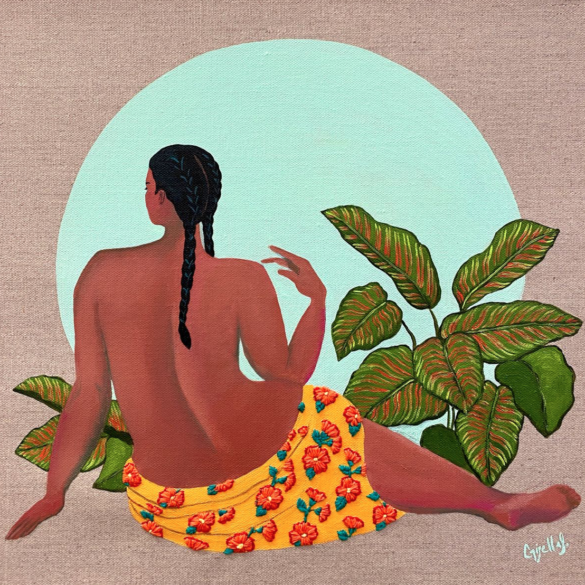Gisella Stapleton is a Peruvian Artist and Muralist who combines different materials ranging from recycled fabrics to organic pigments and embroidery threads that allow her to create more sustainable and environmentally friendly works of art.
How has your lived experience shaped your practice?
Experiences always mark us and shape us throughout life and certainly have a direct influence on my painting. I have been lucky enough to grow up in a family full of love and in a beautiful country like Peru, but at the same time I have lived typical experiences of a conservative and sexist society, social inequality (including gender inequality) is a constant and a pending task. Another experience that has marked my person and my work is having studied the career in Education and thanks to this having worked in marginal areas of my city (Lima) where I met fighting mothers organising community kitchens, these experiences opened the doors to more deeper reflexions as that of social justice and the importance of women as empowerers of the community. On the other hand, having migrated twice (to Spain in 2003 and England in 2011) and alone (without my family) and always working hard to achieve my goals, has made me stronger and more aware of the power we have as women.
Can you tell us more about your focus on women and bodies in your work?
The empowered woman is a theme that I constantly explore in my work, I try to represent her in different ways, not only through looks or positions that speak of it, but also through moments of intimacy and being with herself, moments of relaxation, care and self-love. We live in a constant race all the time, work, family, even fighting for something better, but sometimes we don’t take a moment to evaluate how we feel, what we think, what we are doing. From there is born this need of mine to start looking for a moment of rest and reflection, a moment for me, for my being, to listen to my mind and my body, as an important part of the empowerment process. My latest works on women and bodies represent this.
In your work you say that you include “embroidery as a a tool for female empowerment and peaceful protest” Can you tell us more about how this emerged and what role this plays in your work?
Regarding embroidery, I consider it as an empowerment tool from two perspectives. The first is that this has been considered until the last century as a women’s task, embroidering well was almost a symbol of being a future good wife and mother. As a counterpart, for some decades now, embroidery has been used by feminist groups as a tool for peaceful protest, women are re-claiming embroidery to communicate our concerns, claims, struggles, etc. In my specific case, embroidery complements the intention of the message that I want to communicate with my painting. The second is that, until the last century, embroidery was not only a task for women, but it was not considered art, it was rather a trade. or craft. The field of art was made up mostly of male painters. For this reason, embroidering directly on one of my works also seems to me an act of rebellion against the old structures. Not only because I am a woman painting women from a vision of empowerment but also because I complement it with this technique almost excluded from art.
On the other hand, the act of embroidering takes me to a state of peace and reflection that I had not known before, for me it is being a moment of healing and finding myself.
Where are you based and what excites you about the creative community around you?
I am based in London, I find this city full of opportunities for artists, I have done many collaborations for the Latino community as well as for projects with universities, charities, and other entities. I like the diversity of people in this city, artists from all over the world sharing projects, ideas, collaborations, it’s exciting.See more of Gisella’s work on instagram















